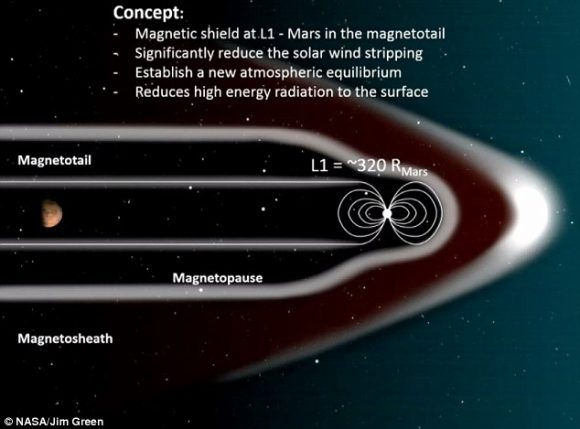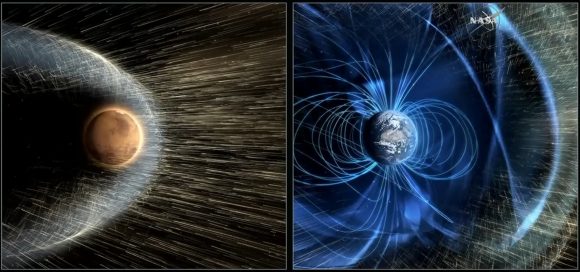This week, NASA’s Planetary Science Division (PSD) hosted a community workshop at their headquarters in Washington, DC. Known as the “Planetary Science Vision 2050 Workshop“, this event ran from February 27th to March 1st, and saw scientists and researchers from all over the world descend on the capitol to attend panel discussions, presentations, and talks about the future of space exploration.
One of the more intriguing presentations took place on Wednesday, March 1st, where the exploration of Mars by human astronauts was discussed. In the course of the talk, which was titled “A Future Mars Environment for Science and Exploration“, Director Jim Green discussed how deploying a magnetic shield could enhance Mars’ atmosphere and facilitate crewed missions there in the future.
The current scientific consensus is that, like Earth, Mars once had a magnetic field that protected its atmosphere. Roughly 4.2 billion years ago, this planet’s magnetic field suddenly disappeared, which caused Mars’ atmosphere to slowly be lost to space. Over the course of the next 500 million years, Mars went from being a warmer, wetter environment to the cold, uninhabitable place we know today.

This theory has been confirmed in recent years by orbiters like the ESA’s Mars Express and NASA’s Mars Atmosphere and Volatile EvolutioN Mission (MAVEN), which have been studying the Martian atmosphere since 2004 and 2014, respectively. In addition to determining that solar wind was responsible for depleting Mars’ atmosphere, these probes have also been measuring the rate at which it is still being lost today.
Without this atmosphere, Mars will continue to be a cold, dry place where life cannot flourish. In addition to that, future crewed mission – which NASA hopes to mount by the 2030s – will also have to deal with some severe hazards. Foremost among these will be exposure to radiation and the danger of asphyxiation, which will pose an even greater danger to colonists (should any attempts at colonization be made).
In answer to this challenge, Dr. Jim Green – the Director of NASA’s Planetary Science Division – and a panel of researchers presented an ambitious idea. In essence, they suggested that by positioning a magnetic dipole shield at the Mars L1 Lagrange Point, an artificial magnetosphere could be formed that would encompass the entire planet, thus shielding it from solar wind and radiation.
Naturally, Green and his colleagues acknowledged that the idea might sounds a bit “fanciful”. However, they were quick to emphasize how new research into miniature magnetospheres (for the sake of protecting crews and spacecraft) supports this concept:
“This new research is coming about due to the application of full plasma physics codes and laboratory experiments. In the future it is quite possible that an inflatable structure(s) can generate a magnetic dipole field at a level of perhaps 1 or 2 Tesla (or 10,000 to 20,000 Gauss) as an active shield against the solar wind.”

In addition, the positioning of this magnetic shield would ensure that the two regions where most of Mars’ atmosphere is lost would be shielded. In the course of the presentation, Green and the panel indicated that these the major escape channels are located, “over the northern polar cap involving higher energy ionospheric material, and 2) in the equatorial zone involving a seasonal low energy component with as much as 0.1 kg/s escape of oxygen ions.”
To test this idea, the research team – which included scientists from Ames Research Center, the Goddard Space Flight Center, the University of Colorado, Princeton University, and the Rutherford Appleton Laboratory – conducted a series of simulations using their proposed artificial magnetosphere. These were run at the Coordinated Community Modeling Center (CCMC), which specializes in space weather research, to see what the net effect would be.
What they found was that a dipole field positioned at Mars L1 Lagrange Point would be able to counteract solar wind, such that Mars’ atmosphere would achieve a new balance. At present, atmospheric loss on Mars is balanced to some degree by volcanic outpassing from Mars interior and crust. This contributes to a surface atmosphere that is about 6 mbar in air pressure (less than 1% that at sea level on Earth).
As a result, Mars atmosphere would naturally thicken over time, which lead to many new possibilities for human exploration and colonization. According to Green and his colleagues, these would include an average increase of about 4 °C (~7 °F), which would be enough to melt the carbon dioxide ice in the northern polar ice cap. This would trigger a greenhouse effect, warming the atmosphere further and causing the water ice in the polar caps to melt.

By their calculations, Green and his colleagues estimated that this could lead to 1/7th of Mars’ oceans – the ones that covered it billions of years ago – to be restored. If this is beginning to sound a bit like a lecture on how to terraform Mars, it is probably because these same ideas have been raised by people who advocating that very thing. But in the meantime, these changes would facilitate human exploration between now and mid-century.
“A greatly enhanced Martian atmosphere, in both pressure and temperature, that would be enough to allow significant surface liquid water would also have a number of benefits for science and human exploration in the 2040s and beyond,” said Green. “Much like Earth, an enhanced atmosphere would: allow larger landed mass of equipment to the surface, shield against most cosmic and solar particle radiation, extend the ability for oxygen extraction, and provide “open air” greenhouses to exist for plant production, just to name a few.”
These conditions, said Green and his colleagues, would also allow for human explorers to study the planet in much greater detail. It would also help them to determine the habitability of the planet, since many of the signs that pointed towards it being habitable in the past (i.e. liquid water) would slowly seep back into the landscape. And if this could be achieved within the space of few decades, it would certainly help pave the way for colonization.
In the meantime, Green and his colleagues plan to review the results of these simulations so they can produce a more accurate assessment of how long these projected changes would take. It also might not hurt to conduct some cost-assessments of this magnetic shield. While it might seem like something out of science fiction, it doesn’t hurt to crunch the numbers!
Stay tuned for more stories from the Planetary Science Vision 2050 Workshop!
Further Reading: USRA


How do you hold the magnetic shield against the pressure of the solar wind in the Mars L1 Lagrange Point?
it’s called Physics; look it up, a fascinating subject
‘Physics’ is no substitute for a gravitational potential well, which Lagrange points are not. Any resistance to, or deflection of, the solar wind will cause the ‘shield’ to move off the point. Thus the thing will require propellant and thrusters. Looking at their PDF, I see not the slightest trace they’ve accounted for this Grade 12 science-class item.
Good point, I wonder how high the force to compensate for would be. Maybe in the range of electric propulsion.
Hey SETI, go searching for magnetic anomalies around nearby stars asap!
Ah, possible resolution to the Fermi Paradox, huh? Well, not a bad idea. Every time we come up with something, its a safe bet someone thought of it long before we did 🙂
A very good idea, indeed!
This concept is not as far fetched as it may first seem. 2T magnetic shields are being produced as we speak as hardware for the newest wave of MRIs . Getting one to the Mars L1 Lagrange point and keeping it stationary is certainly within the capability of current propulsive technology. The obvious hurdles are going to be maintenance/reliability and cost. Any such device needs to stay in reliable service, preferably for decades at minimum and not break down. Servicing the device would likely be as expensive as getting it there in the first place unless it is manufactured simply enough to allow for a robotic/remote repair/maintenance mission. It is also comforting to know that if a magnetic pole reversal occurs on this planet in the near future that we have a way of managing this with ease with current technology rather than having everyone live underground or risk dying of radiation poisoning in a few years during such an event.
One other thought with regards to the topic. The magnetic shields associated with MRIs consume a considerable amount of power, so a station at the L1 Lagrange point would have to have a pretty hefty solar array to capture enough sunlight at that distance from the sun to keep the device powered up. It may make sense to keep costs down to use nuclear fuel to help generate electricity.
I’ve got another idea:
Bring all the radioactive waste from Earth and bury it on Mars.
Over time it will heat up Mars’ core and jump-start its dynamo,
thus bringing back its magnetic field.
Do you think that’s feasible?
no
Want to heat up Mars fast and liberate a lot of water and gases? Use fusion devices to bring Phobos (Mass 1.0659×1016 kg[1]) out of orbit. Traveling at a velocity of 2.138 km/s it should make quite the disruption to the crust of the planet.
hi all,
can you see the link below? it is a blog that have proposed the idea of “shielding” back at 2015.
https://globalprovidence.blogspot.gr/2015/02/what-about-plasma-shield.html
Not practical. There is a reason we do not have plasma shields already. The biggest problem is powering the device, it would require a great deal more power than a magnetic shield. You have to superheat the plasma, after all. Plasma shields are also opaque to all forms of EM radiation and that is a problem when using one on a ship as you won’t be able to see through it and would have to turn it off to navigate. I will post a link to an article that describes these practical concerns in more detail:
https://www.extremetech.com/extreme/181773-physics-students-figure-out-how-to-make-star-wars-deflector-shields-in-real-life